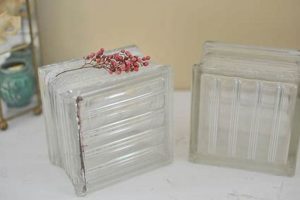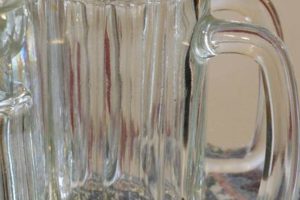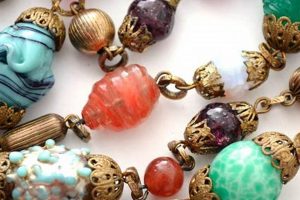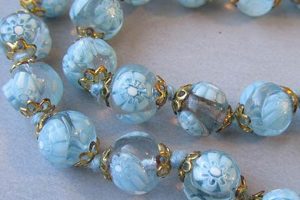Collectible glassware featuring floral patterns produced during earlier eras, often dating from the mid-20th century, are characterized by delicate designs etched, painted, or pressed onto glass surfaces. Examples include tumblers, stemware, and decorative pieces adorned with roses, daisies, or abstract botanical motifs.
These items offer tangible links to past aesthetics and lifestyles. Their appeal stems from both their decorative qualities and their potential as valuable collectibles. The craftsmanship reflects manufacturing techniques and design trends prevalent in their respective periods of origin, providing insights into social and artistic history.
This article will explore various aspects of these botanical-themed glassware, including identifying characteristics, evaluating their condition, and understanding their market value. Preservation methods and resources for collectors will also be addressed.
Tips for Acquiring and Preserving Floral-Themed Vintage Glassware
The following guidelines are provided to assist collectors in the acquisition and preservation of floral-themed vintage glassware. Careful consideration of these points will contribute to the long-term enjoyment and potential appreciation of these items.
Tip 1: Research Market Values: Before purchasing, investigate comparable sales data from reputable sources, such as auction houses and antique dealers. This will provide a realistic understanding of current market prices for specific patterns and pieces.
Tip 2: Inspect for Damage: Thoroughly examine each item for chips, cracks, scratches, or cloudiness. Minor imperfections may be acceptable in some cases, but significant damage will detract from the item’s value and structural integrity.
Tip 3: Identify the Pattern: Floral-themed vintage glassware often features distinct patterns. Consult reference guides and online databases to accurately identify the pattern name and manufacturer. This information is crucial for determining rarity and value.
Tip 4: Assess Glass Quality: Examine the clarity, color, and weight of the glass. Higher quality glass typically exhibits greater clarity and a consistent color distribution. Original pieces often possess a distinctive weight characteristic of the manufacturing period.
Tip 5: Consider Storage Conditions: Store glassware in a dry, dust-free environment away from direct sunlight. Ultraviolet radiation can fade colors and degrade the glass over time. Padded shelving or display cases are recommended to prevent accidental damage.
Tip 6: Employ Gentle Cleaning Methods: Clean glassware with warm water and a mild detergent. Avoid abrasive cleaners or scouring pads, which can scratch the surface. Hand-drying with a soft cloth is preferred to air-drying, which can leave water spots.
Tip 7: Document Purchases: Maintain a detailed record of each acquisition, including the purchase date, price, condition, and provenance (if known). This documentation will be valuable for insurance purposes and for future resale opportunities.
Adhering to these recommendations will enhance the collector’s ability to make informed purchasing decisions and ensure the longevity of these delicate and historically significant objects. By focusing on research, careful examination, and proper preservation, a collection of floral-themed vintage glassware can be both aesthetically pleasing and financially rewarding.
The subsequent sections will delve into specific patterns, manufacturers, and regional variations within the realm of vintage floral-themed glassware.
1. Floral Motif Variations
The diversity of floral motifs constitutes a significant dimension in the realm of botanical-themed vintage glassware. These variations directly influence desirability, collectible value, and historical context. Differences in style, from realistic depictions to stylized abstractions, arise from artistic preferences, manufacturing capabilities, and prevailing design trends of particular periods. The selection of specific flower types, such as roses, lilies, or daisies, reflects cultural symbolism and seasonal availability, impacting the aesthetic appeal of individual pieces. Consequently, specific variations become associated with particular eras or manufacturers, enabling accurate dating and attribution.
Variations extend beyond mere representation to encompass the techniques employed in rendering the floral designs. Etched designs, common in elegant stemware, offer a delicate and refined appearance. Hand-painted motifs, prevalent in art deco examples, exhibit a more vibrant and individualistic quality. Pressed glass techniques, often used during the Depression era, produced more affordable glassware with simpler, raised floral patterns. Real-world examples include the intricate rose patterns found on Cambridge Glass stemware, the bold, stylized floral designs characteristic of Hazel Atlas glassware, and the subtle, etched flower motifs on Heisey glassware. An understanding of these stylistic and technical variations is crucial for collectors seeking to differentiate between authentic vintage pieces and later reproductions.
In summary, floral motif variations are integral to appreciating the artistic and historical value of botanical-themed vintage glassware. These variations serve as diagnostic features for identification, dating, and valuation. Collectors and enthusiasts benefit from a comprehensive understanding of stylistic trends, manufacturing techniques, and cultural influences that shaped the diverse range of floral designs adorning these collectible items. Recognizing these nuances allows for informed collecting decisions and the preservation of these artifacts for future generations.
2. Glass Manufacturing Eras
The era in which botanical-themed vintage glassware was manufactured profoundly influenced its composition, design, and overall aesthetic. Technological advancements, economic conditions, and prevailing artistic movements of each period left an indelible mark on these collectible items, making an understanding of manufacturing eras crucial for collectors and enthusiasts.
- Early American Pressed Glass (1820s-1900s)
This era saw the rise of mass production through mechanical pressing. Floral patterns, often simplistic and symmetrical, were imprinted onto glass items, making decorative glassware more accessible to the general public. Examples include pressed glass cake stands and compotes featuring raised floral designs. The relatively lower cost of production contributed to the widespread availability of these items.
- Art Nouveau Era (1890-1910)
Characterized by organic forms and flowing lines, the Art Nouveau period embraced nature as a primary source of inspiration. Glass manufacturers such as Lalique and Daum Frres created elaborate pieces featuring hand-painted or etched floral motifs. These pieces often exhibit iridescence and subtle color variations, reflecting the era’s emphasis on artistic expression.
- Depression Era (1930s)
Economic hardship during the Great Depression led to the production of inexpensive, mass-produced glassware. Often referred to as “Depression glass,” these items were typically made from colored glass and featured simple pressed patterns, including stylized floral designs. Manufacturers like Hazel Atlas and Jeannette Glass produced numerous examples, which remain popular among collectors due to their affordability and historical significance.
- Mid-Century Modern Era (1945-1960s)
This era embraced bold colors, geometric shapes, and a sense of optimism. Floral patterns on glassware from this period often reflected these trends, featuring abstract or stylized representations of flowers. Manufacturers such as Anchor Hocking and Federal Glass produced colorful glassware sets adorned with floral motifs. The durability and practicality of these items made them suitable for everyday use.
By examining the manufacturing techniques and design characteristics of each era, collectors can accurately identify and appreciate the historical significance of botanical-themed vintage glassware. The materials used, the production methods employed, and the artistic styles embraced all contribute to the unique character of these collectible items, providing a tangible link to the past.
3. Collectible Condition Evaluation
The assessment of condition is paramount when evaluating the value of botanical-themed vintage glassware. The presence or absence of damage, such as chips, cracks, or scratches, directly impacts an item’s desirability and market price. Furthermore, the degree of discoloration, fading, or staining affects the overall aesthetic appeal and perceived quality. For instance, a Depression-era glass pitcher with a vibrant floral design will command a significantly higher price if it exhibits minimal wear compared to an identical pitcher with noticeable cloudiness or a chipped rim. Therefore, collectible condition serves as a primary determinant in establishing the monetary worth of these items.
Beyond mere aesthetics, condition assessment provides insights into the item’s history and usage. The presence of watermarks inside a vase may indicate prolonged use, while the absence of scratches on the base suggests careful handling. Examining wear patterns can also reveal whether an item was primarily displayed or frequently used. Identifying the type of damage, such as a crack resulting from thermal shock versus a chip caused by impact, can further illuminate the object’s past. For example, staining could indicate prolonged storage with liquids and may be difficult to remove. These insights into the item’s lifespan contribute to its overall story and historical significance.
In conclusion, the evaluation of collectible condition is an indispensable aspect of appraising botanical-themed vintage glassware. It not only influences the financial value but also provides valuable clues about the item’s history and usage. Accurate condition assessment requires careful observation, a thorough understanding of potential damage types, and knowledge of restoration techniques. Addressing these factors is essential for making informed purchasing decisions and ensuring the preservation of these fragile artifacts.
4. Design Popularity Fluctuations
The market for botanical-themed vintage glassware experiences cycles of increased and decreased demand, directly impacting value and collectibility. These fluctuations are driven by shifting consumer preferences, influenced by factors such as interior design trends, historical revivals, and media portrayals. For example, the resurgence of mid-century modern aesthetics has fueled renewed interest in glassware featuring abstract floral patterns characteristic of that era. Conversely, a decline in the popularity of a particular style or color palette can lead to decreased demand and lower prices for associated pieces. This dynamic interplay between design trends and market value underscores the importance of understanding design popularity fluctuations for collectors and dealers.
The cyclical nature of design popularity can be observed across various historical periods. During the Victorian era, ornate floral designs were highly prized, reflecting the prevailing emphasis on elaborate decoration. However, subsequent movements, such as Art Deco and Minimalism, favored simpler, more geometric forms, leading to a decline in the popularity of Victorian-era glassware. More recently, the renewed appreciation for vintage and antique items has spurred a resurgence in interest in glassware from various periods, showcasing the cyclical nature of design trends. Practical application of this understanding involves adapting collecting or dealing strategies in response to changes in demand. Monitoring design blogs, attending antique shows, and tracking auction results can provide valuable insights into emerging trends and potential investment opportunities.
In summary, design popularity fluctuations exert a significant influence on the market for botanical-themed vintage glassware. Shifts in consumer preferences, driven by various cultural and economic factors, create periods of increased and decreased demand, impacting value and collectibility. A proactive approach, involving continuous monitoring of design trends and adaptation of collecting strategies, is essential for navigating this dynamic market and maximizing potential returns. Understanding these fluctuations links directly to the broader theme of appreciating these items, not just for their intrinsic beauty, but as reflections of cultural and economic shifts throughout history.
5. Market Value Assessment
Market value assessment for botanical-themed vintage glassware is a complex process driven by the interplay of several factors. A comprehensive evaluation necessitates consideration of condition, rarity, provenance, and current demand. The interplay of these elements directly impacts the financial worth of individual pieces and entire collections. For example, a piece from a limited production run by a recognized manufacturer, exhibiting minimal wear, and possessing documented historical ownership, commands a premium price compared to a common, damaged example lacking provenance.
The significance of accurate market value assessment lies in its ability to inform purchasing decisions, facilitate insurance coverage, and guide estate planning. A properly assessed value enables collectors to make informed acquisitions, avoiding overpayment for items. Appraisals provide the necessary documentation for insuring collections against loss or damage, ensuring adequate compensation. Furthermore, accurate valuation is essential for estate planning purposes, allowing for equitable distribution of assets among heirs. One practical application involves comparing sales data from reputable auction houses to determine prevailing market prices for similar items. Another application is consulting with experienced appraisers specializing in vintage glassware to obtain professional valuations.
In conclusion, market value assessment is an indispensable component of collecting and managing botanical-themed vintage glassware. While challenges exist in accurately determining value due to fluctuating demand and subjective condition assessments, a diligent approach incorporating research, expert consultation, and detailed documentation is crucial. A thorough understanding of market valuation principles not only protects financial investments but also contributes to the preservation and appreciation of these unique cultural artifacts.
Frequently Asked Questions Regarding Vintage Flower Glasses
The following section addresses common inquiries and misconceptions surrounding botanical-themed vintage glassware. These questions aim to provide clear, concise information to collectors, enthusiasts, and individuals seeking to understand the intricacies of these items.
Question 1: What defines an item as “vintage” in the context of botanical-themed glassware?
Generally, glassware manufactured at least 50 years prior to the present day is considered vintage. This definition accounts for the passage of time and the shift in manufacturing techniques and design aesthetics.
Question 2: How can one differentiate between authentic botanical-themed vintage glassware and modern reproductions?
Authenticity is often determined by examining manufacturing marks, construction techniques, and design details characteristic of specific eras. Modern reproductions may exhibit inconsistencies in color, weight, or pattern detail when compared to original pieces.
Question 3: What factors contribute to the market value of these items?
Market value is influenced by several factors, including condition, rarity, manufacturer, design complexity, and provenance. Pieces in excellent condition, produced in limited quantities, or associated with prominent manufacturers command higher prices.
Question 4: What are the recommended cleaning methods for botanical-themed vintage glassware?
Gentle cleaning with warm water and a mild detergent is recommended. Abrasive cleaners or scouring pads should be avoided, as they can scratch the surface. Hand-drying with a soft cloth is preferred to prevent water spots.
Question 5: How should botanical-themed vintage glassware be stored to prevent damage?
Storage in a dry, dust-free environment away from direct sunlight is recommended. Padded shelving or display cases should be utilized to minimize the risk of accidental breakage. Exposure to extreme temperatures should be avoided.
Question 6: Where can reliable information about identifying and valuing botanical-themed vintage glassware be found?
Reputable sources include reference books specializing in vintage glassware, online databases maintained by collectors’ organizations, and consultations with experienced appraisers or antique dealers.
In summary, understanding the nuances of identification, valuation, and preservation is crucial for those engaging with botanical-themed vintage glassware. Diligence in research and careful handling are essential for appreciating and maintaining these items.
The following section explores specific examples of prominent manufacturers and their contributions to the world of botanical-themed vintage glassware.
Conclusion
This exploration of botanical-themed glassware has encompassed aspects ranging from manufacturing eras and design variations to condition evaluation and market valuation. Consideration of these elements is essential for collectors, historians, and enthusiasts seeking to appreciate these artifacts. The intricate interplay of historical context, artistic expression, and economic factors shapes the desirability and significance of these pieces.
Continued research and careful preservation efforts are crucial to ensuring the longevity of this tangible connection to past aesthetics and lifestyles. Recognizing the cultural and economic forces that influenced their creation deepens the appreciation for these fragile objects and allows future generations to engage with the stories they represent.







